2017 Red Jacket Honorees
PharmaVOICE introduced the Red Jacket Award in 2014 to celebrate the 10th anniversary of the PharmaVOICE 100.
One of the criteria for being named a Red Jacket — our version of a Hall of Fame — is having been recognized previously as a PharmaVOICE 100 honoree, but it’s much more than that. These individuals, who cross a multitude of industry sectors, have raised the bar in terms of what it means to be an inspired leader for their teams, their companies, their communities, and for the industry at large.
Red Jacket Honorees:
Challenge us to think differently, act differently, and lead differently
They are creating new opportunities to make what was once impossible — possible
They are focused beyond short-term gains and are committed to executing their long-term
visions in a tightly regulated and competitive industry
They have a persistence of vision
They are truly transforming the life-sciences industry to create better health outcomes for all
They are inspired leaders for today and tomorrow
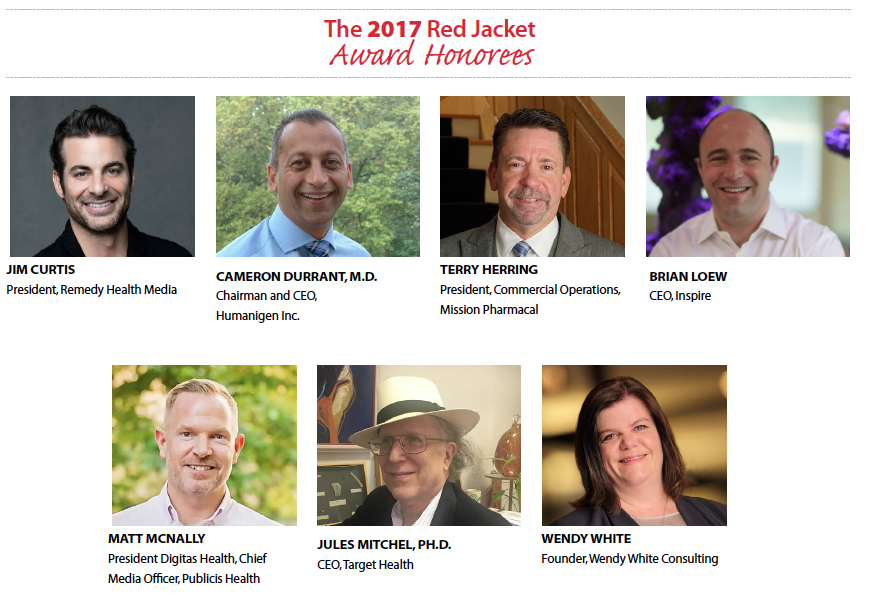
Jim Curtis
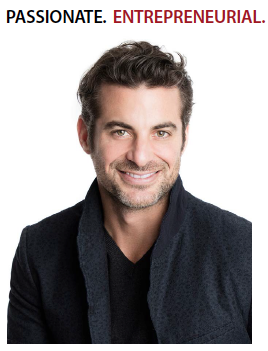 A Personal Journey of Transformation
A Personal Journey of Transformation
TITLE: President
COMPANY: Remedy Health Media
EDUCATION: Whittemore School of Business and Economics, University of New Hampshire
FAMILY: Son, Aidan; nieces, nephews, two sisters, two brother-in-laws, parents
AWARDS/HONORS: PM360 Elite 2015: Disrupter; MM&M Awards: 2016 Best Healthcare Consumer Media Brand (HealthCentral), 2014 Media Brand of the Year (Remedy Health Media); Crain’s Business New York Fast 50, New York Best Places to Work; PharmaVOICE 100 2013, 2014, 2015
ASSOCIATIONS: Board Advisor, Seamless Medical and Reilly’s HempVet; active member of Project Sunshine; founder of the Lawrence Rosenfield Scholarship Fund at the University of New Hampshire; Upstream Group, 212 Interactive, and Digital Media Group
A 20-year patient with an undiagnosed condition, Jim Curtis has been there, done that. He has searched all over the world, in every discipline, covered every option to identify and treat his illness. It was this journey — that did not end with a diagnosis or a cure — that led him to create a patient storytelling platform, write a book, produce a video series, and craft a new philosophy on survival.
Through his journey, the three-time PharmaVOICE 100 honoree discovered that he — and most chronically ill patients — end up in a type of survival mode where “being okay" is good enough. They pull inward and show a false bravado to the world because they may feel shame regarding their condition, plus it is emotionally and physically tiring to deal every day with a chronic illness. Mr. Curtis discovered that if this attitude of just getting by could be changed, patients might learn to feel joy, and look forward to the future, rather than just get through the day. He says patients must first become vulnerable, before they can be receptive to support that will allow them to create amazing things.
Based on his personal journal, Mr. Curtis has developed patient-centric health information and tools that benefit millions of chronic condition sufferers.
“After I opened up about my own healthcare experience, I realized I could create something from this," he says. “This led to the storytelling initiative for Remedy."
After ideating, developing, and launching Remedy Health’s very successful multimedia storytelling initiative, Live Bold, Live Now, in 2014, over the course of the last three years, Mr. Curtis provided the vision and strategy to expand the product line. 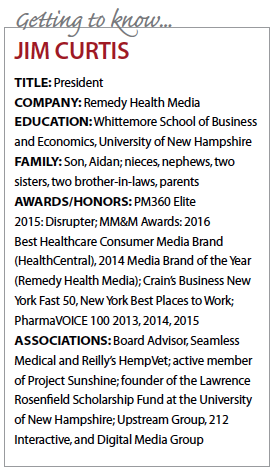 Today, under the Live Bold, Live Now umbrella, Remedy has six engaging storytelling formats available, from long-form videos to moments-based photojournalistic experiences.
Today, under the Live Bold, Live Now umbrella, Remedy has six engaging storytelling formats available, from long-form videos to moments-based photojournalistic experiences.
In 2016, Mr. Curtis also took Remedy’s storytelling concept to a new level, leading the Remedy team to launch the first patient-focused health storytelling platform seemystory.io. The recently launched platform allows patients to craft their own multimedia story, inspire others, and motivate through purpose. Mr. Curtis believes everyone has a health story to tell and through research he has found that when patients share their stories it fosters better health through the significance of the contribution.
In 2016, along with writing his book, “The Stimulati Experience, 9 Skills for Getting Past Pain, Setbacks, and Trauma to Ignite Health and Happiness," out this summer, Mr. Curtis also created a personal storytelling initiative using his family and friends as subjects. Entitled ELDERS, there are nine volumes that can be watched on YouTube. Bring your tissues.
Mr. Curtis has been the driving force behind the significant growth and expansion of Remedy into an award-winning powerhouse digital company. Under his leadership Remedy’s online traffic has grown 30% and the company has produced 290 inspirational health stories differentiating it from other encyclopedic and non-inspirational competitive health sites.
PV: How are you driving innovation in your company and throughout the industry?
Curtis: The biggest way to drive innovation in digital health is to look outside of digital health. A patient is only a patient when he or she is in the hospital or doctor’s office. Patients don’t identify with being a patient when they are at home dealing with life. They go back to being a person. So why in digital health do we constantly put people in the digital hospital, meaning driving them to sites like WebMD, or Everyday Health, or Remedy Health? It’s as if we create a content hospital space.
However, patients’ real lives revolve around action-oriented content, such as Instagram, Pinterest, Twitter, even ESPN or other things that they’re doing. So, the way that we innovate is to evaluate what is a real human healthy interaction that excites people outside of health. And then we look to how we can recreate that experience so that there is a benefit for people’s health without making them feel like they’re in the digital hospital.
We try to recreate the wheel for health by creating immersive, multi-media stories such as you would find in the best parts of the New York Times.
Or we create moments-based storytelling, which is impactful photographs with three or four lines of content, such as what National Geographic or Humans of New York does. We use TV quality video and then we hire editors who know how to tap into the emotion so that we can affect change and get people to take healthy actions. This is how we innovate.
PV: What’s your take on the disruption or transformation movement that is happening?
Curtis: Well, it’s definitely happening. We see a lot of non-endemic companies to the pharma world or to health looking to get in. This makes sense because people are human and we can’t categorize someone as a patient or not a patient. Facebook can be endemic if it ends up serving up health content as envisioned.
I believe that we can’t have transformation without disruption. So it’s not one or the other in my mind. It is a process. First there has to be a spark that something different can happen. And oftentimes this means, by putting energy and force into the something different means that there is intent to disrupt what’s currently happening. And if you don’t have that growth there’s no transformation. Without transformation, you don’t get to a better place.
I think what’s happening is good and will force everybody to do better for the end result, which is a person seeking health to have better health.
PV: How do you believe collaboration around the ecosystem will impact innovation and drive improvements from R&D to commercial innovation?
Curtis: We live in a space where nobody can do anything alone. Businesses can’t operate without vendors. A service provider needs the people its serving, people who need that service need the business, the business needs vendors to help supply the services. Without collaboration nothing gets done. The more we work together the better we get. I believe that we need collaboration, especially in healthcare. If we can collaborate more then we can have more of a straight line toward action: content leads to inspiration, which leads to action, which leads to assessment, which leads to treatment, which leads to follow through, which leads to better outcomes. That’s great collaboration.
PV: How do you look to develop that next generation of leaders?
Curtis: I love mentoring. Mentoring is super important to me. Most recently I’ve been doing talks at colleges and business schools; they will have me in to talk about marketing. I always talk about making the emotional connection. Recently I’ve been at Fordham, Harvard, Wharton and I’m going to University of New Hampshire and NYU soon. Most of the time it’s small groups of 30. We work on marketing projects and then we often have competitions, and I work as a collaborator or a judge. This is how I’m mentoring the next generation of leaders, and I love doing it.
PV: What would you like your legacy to be?
Curtis: I would like to be remembered as the patient advocate entrepreneur. Meaning, as a patient, someone who is really interested in delivering what’s important to patients so people can get better, live better, and be happier. And as someone who had the vision to help companies create these life-enhancing products. (PV)
Dr. Cameron Durrant
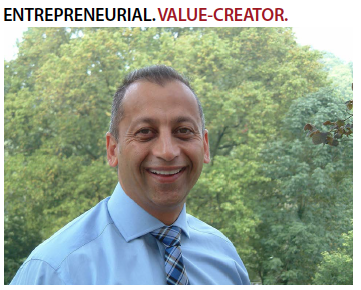 The Turn-Around Artist
The Turn-Around Artist
Title: CEO and Chairman
Company: Humanigen Inc.
Education: MD, Welsh National School of Medicine, Cardiff; Diploma of the Royal College of Obstetricians and Gynecologists, London; Member of the Royal College of General Practitioners, London; Diploma of Clinical Hypnotherapy, Australian Academy; MBA, Henley Management College, Oxford
Awards/Honors: M&A Advisors 2017 Turnaround Award for Chapter 11 Reorganization of the Year ($10MM to $25MM) for KaloBios EY Regional Healthcare Entrepreneur of the Year 2005
Social Media:
Tweet at: @cdurrant
Cameron Durrant, CEO and chairman, Humanigen, does not shrink from a challenge. The five-time PharmaVOICE 100 honoree began the clean up of the company that was formerly KaloBios in January 2016. Taking over in the wake of the former CEO’s ouster and arrest for events completely unrelated to KaloBios, Dr. Durrant has gained significant ground much of which has been an uphill battle. The flailing biotech company was taken into bankruptcy with a myriad of other hurdles, including law suits, Nasdaq delisting, pricing misconceptions, an uncertain pipeline and plenty else that almost defies the imagination.
Colleagues say Dr. Durrant displayed vanguard industry leadership while he quickly brought about the changes Humanigen needed to survive.
Few leaders in pharma have been confronted with the number and level of issues threatening day-to-day operations as he has at Humanigen. To set the tone for how the company would change, he created a Responsible Pricing Model, a groundbreaking pricing and transparency operating framework that preceded any other similar industry pricing commitment, including Allergan’s Social Contract by five months. The Responsible Pricing Model provides clarity on how Humanigen will act as a company, how it will provide sustained value for all stakeholders, and the basis for transformation.
Dr. Durrant’s next step was to lead Humanigen through a very complicated bankruptcy. Aside from navigating the legal issues precipitated by previous management, he refocused the company’s assets on neglected and rare diseases to create a unique near-term and long-term value creation model. One part of this strategy was the acquisition of certain rights to develop benznidazole for potential FDA approval for the treatment of Chagas disease, a neglected tropical disease with potentially life-threatening outcomes for which there are no approved therapies in the United States.
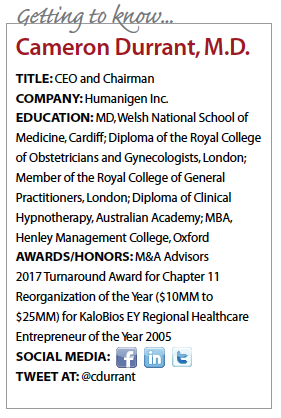 Under his leadership, the beleaguered company swiftly emerged from bankruptcy on June 30, 2016, which was viewed by many experts as an extraordinary achievement. Pipeline milestones followed quickly thereafter. Dr. Durrant and this team executed and continued to drive the pipeline programs forward despite limited resources amid incredible distractions in bankruptcy and beyond. Key programs — benznidazole and lenzilumab — gained momentum over the past year and remain on track. Important milestones achieved include a Phase I trial start for lenzilumab, positive FDA guidance meetings for benznidazole, and most recenty FDA clearance in June of benznidazole’s investigational new drug (IND) application and receipt of orphan drug designation. In addition, the company also co-sponsored a conference earlier in the year on Chagas disease in Washington, D.C., something that would have been unthinkable when Dr. Durrant took over.
Under his leadership, the beleaguered company swiftly emerged from bankruptcy on June 30, 2016, which was viewed by many experts as an extraordinary achievement. Pipeline milestones followed quickly thereafter. Dr. Durrant and this team executed and continued to drive the pipeline programs forward despite limited resources amid incredible distractions in bankruptcy and beyond. Key programs — benznidazole and lenzilumab — gained momentum over the past year and remain on track. Important milestones achieved include a Phase I trial start for lenzilumab, positive FDA guidance meetings for benznidazole, and most recenty FDA clearance in June of benznidazole’s investigational new drug (IND) application and receipt of orphan drug designation. In addition, the company also co-sponsored a conference earlier in the year on Chagas disease in Washington, D.C., something that would have been unthinkable when Dr. Durrant took over.
A leader from the front, Dr. Durrant says adversity is a great teacher, and he would prefer confronting a vexing strategic and operational challenge than to have an easy march as a CEO.
“You can’t panic when things get tough," he says. “I don’t ask for things to be easier; I ask of myself to be better – to find a way to get things done."
PV: What would you say to the industry about being innovative and taking some risks?
Durrant: I think it starts with being completely dissatisfied with the status quo; however well you may think you’re doing, you could always do it better. I think there is a mindset and a restlessness, if you will, with the situation you’re in.
There are a lot of ways to describe innovation, and it doesn’t necessarily mean a new product. It could be using existing products and services in different ways and stitching them together in different ways. I think that at the heart of innovation is a creativity mindset. It could be around products, science, finance, deals, people, and trying to connect those dots in non-obvious ways. This often leads to a new thought process that starts with ‘well, what if we did such and such?’
I think a good example is our Responsible Pricing Model, which we issued more than a year ago now. This model, which has been picked up by other companies in the industry, has attracted a lot of attention. For a tiny biotech company with a troubled recent history to be able to do something like this speaks to how we can drive innovation in the industry, not just within the company.
PV: You made the point that innovation doesn’t necessarily need to be a big huge new product, but it’s disrupting the status quo in terms of getting to better outcomes. Is that a fair assessment?
Durrant: I think it is. We could get into the Webster’s definition of disruption, but typically it has some negative connotations, where there are winners and losers and sometimes the winners set out to create losers. We think of the term transformation, which has a much healthier connotation to it. And we certainly see ourselves as agents of transformation and hope to encourage others to be transformative in the industry.
PV: Where are the biggest gaps in the industry?
Durrant: I think the industry needs a reality check. It’s very difficult to grapple with an issue unless you have an understanding of the brutal realities of that issue. These might be technological advancements. It might be around costs within the healthcare system. It could be around areas that touch on ethical and moral questions in terms of R&D, but we have to be honest and deal with the brutal reality of those issues and not bury our heads in the sand and try to assign blame or point fingers.
I think the future of the life-sciences industry will be equal parts tremendously exciting and terrifying for a lot of people. I see opportunity in transformation and turbulence. A lot of people just complain and say, ‘isn’t it terrible’ and ‘we can’t do this’ and ‘we can’t do that.’ Well, transformation creates an opportunity. Our job is to find the opportunity and leverage that opportunity in a way that benefits our customers first and foremost. Our job is to find the opportunity and leverage that opportunity in a way that benefits our customers first and foremost.
I spoke with someone recently who’s a successful entrepreneur and innovator in the life sciences. He has created dozens of very successful companies, and his view is in the next 10 years we’ll see more transformational and exciting technologies than we have in the last 100 years, and that’s the piece that excites me. I think the industry is even more exciting than it ever has been. If you can operate with speed — speed of thought and speed of execution — then you’re going to find ways through the morass.
PV: Do you devote time to mentoring?
Durrant: I’ve certainly acted as a mentor to a number of people and still do. I remember earlier in my career at Pharmacia — 17 years ago — one of the people at a meeting, who was quite a bit older than me, talking about how important it was for him to give back through mentorship. I thought, “What on earth is he talking about? I’m too busy to be doing that stuff." How I now think about developing, coaching, and mentoring others, compared with that time is night and day.
Today, I feel you don’t have to have a leader title to be able to coach, develop, or mentor and support others. It’s important to mentor because first of all, most people don’t do it. So if you’re actively doing mentoring and you’re doing it in the right way, this differentiates you as a leader.
Secondly, you’re going to learn a lot more from the people who you may be coaching or mentoring in those discussions than you might think. You might learn something about your own company that you don’t know, or something new about the industry, or about deals, about people, about technology, and so on. While mentoring sounds very altruistic and selfless, in some ways it’s a bit selfish because it grows you as a leader, as well as the other person. That’s one of the reasons I’m such an enthusiast about mentoring — those hidden benefits.
PV: How can life-sciences leaders collaborate more effectively to address and solve some of the biggest challenges they are facing?
Durrant: I think often internal dynamics get in the way. This could be politics, resourcing, departmental structure, incentive programs, etc. Being intentional around designing collaborations so they are as seamless as possible is important so those distractions don’t get in the way. If those dynamics are removed, almost naturally there is a more collaborative infrastructure.
PV: What impact do you think collaboration will have on the future of the industry?
Durrant: I think collaborations are tremendously important. There are going to be some winners that are able to leverage relationships better than others in terms of deal making because they have a particular mindset about alliance management.
Every company says it wants to be partner of choice. No company says it wants to be partner of last resort. And yet some companies behave that way. The ability to collaborate is important. The collaboration might be with vendors, providers, policymakers, administrations, NGOs, healthcare professionals — all of which are tremendously important. As an industry, we’ve lost our way as to how to collaborate. I think there’s such pressure on people to deliver the financial outcome, they have forgotten how to work collaboratively.
PV: What would you like your legacy to be?
Durrant: That’s a big question. I would like to be remembered as a value creator. Part of this is about building a culture and understanding how important culture is as a business leverage point. Reputation and relationships are important and I have attempted to develop both of these as positively as possible. I’d also like to think that I’ve attempted to accumulate and dispense wisdom and to help others in their goal setting and in their careers. But ultimately, it’s the value creation as determined by the stakeholders with whom I interact and the people receiving our medicines, who hopefully we are helping. (PV)
Terry Herring
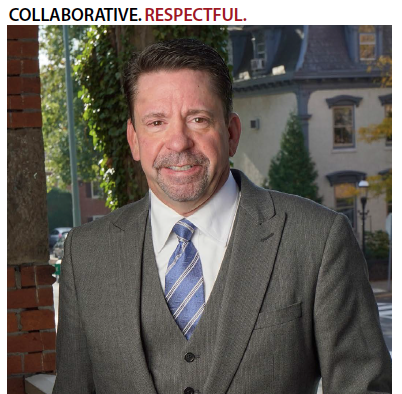 Driven to Collaborate by Solutions
Driven to Collaborate by Solutions
TITLE: President, Commercial Operations
COMPANY: Mission Pharmacal
EDUCATION: BS, Biology, high honors, The Citadel; MBA, Duke University and London Business School; Pharmaceutical Certificate, Fairleigh Dickinson University; Graduate Certificate, Georgia’s Mercer University School of Engineering
AWARDS/HONORS: PharmaVOICE 100 2007, 2008
Two-time PharmaVOICE 100 honoree Terry Herring likes to use movie quotes to guide and inspire his teams, as well as to illustrate his theories on leadership and vision. With that in mind, we offer up one to describe what we have learned about this visionary leader: “If you want to know what a man’s like, take a good look at how he treats his inferiors, not his equals." (Sirius Black, “Harry Potter and the Goblet of Fire")
Mr. Herring firmly believes that leaders need to show integrity in their relationships and that in turn creates longstanding business partnerships, relationships, and mentorships.
“The secret is in how you respect each other, which means sometimes giving tough direction, sometimes giving positive direction, and just having a very real relationship with individuals," he says.
Although that is more difficult to do in today’s high tech, uber-busy world of communication, he still strives for it.
“We do a lot of texting and a lot of emailing, yet are we really connected as true business partners and friends?" he hypothesizes. “I believe technology is great for information, but I think it can interrupt the real relationships that keep things going. It takes time to be a true friend or a true partner, to really listen, and to be truly present. I believe this is where the challenge comes in."
The industry is also being challenged to meet its business needs differently, and Mr. Herring has met that challenge head on as well.
“At Mission, we try to diversify the type of company we are and what we do, and although every company doesn’t have to diversify, I do think as an industry we have to look to other ways to provide value in the healthcare community," he says. “We have to look for other ways to get products to patients. We have to look for other ways to help patients."
According to colleagues, Mr. Herring has brought tremendous value to the marketplace in terms of his contributions to commercial solutions that are extremely well thought out and delivered with excellent tactical execution. His exceptional knowledge of the industry, superior strategic thinking, persistent vision, and knack for developing top talent have brought success for both himself and the organizations he works for.
For example, when he transitioned out of inVentiv Health in 2010, he recognized a huge void in the marketplace: small companies in need of sales staff. He had an idea about how to fill this need and created Alamo Pharma Services, a subsidiary of Mission Pharmacal. As a contract sales organization, Alamo offers sales services to small- to mid-sized companies that lack the needed workforce or infrastructure to affect market impact. Mr. Herring recognized that these types of smaller companies 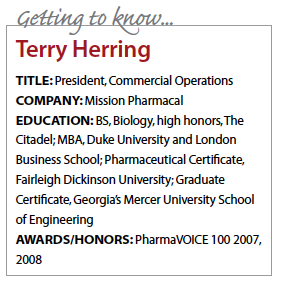 aren’t necessarily looking to partner with big players, or may want more cost-effective commercial solutions. Alamo has since thrived and continues to provide great value to its clients.
aren’t necessarily looking to partner with big players, or may want more cost-effective commercial solutions. Alamo has since thrived and continues to provide great value to its clients.
In 2015 at the Association of Strategic Alliance Professionals—Global Alliance Summit, Mr. Herring challenged those in the audience to overcome their self-imposed boundaries and shared how Mission was able to do so by partnering. This is important because companies tend to do just enough to do well and stay safe, which leads to complacency and failure.
“The best thing I ever learned from a coach — and I say it all the time — is no matter how well I perform, I wasn’t always that good a performer," he says. “I never had a coach in business, athletics, or music who said: ‘Well, I think that’s good enough. You don’t need to get any better.’"
Mr. Herring is always challenging himself and his teams to do better and is open to learning from others. On that note, he uses the famous quote from Remember the Titans’ Coach Yoast: “I hope you boys have learned as much from me this year as I’ve learned from you And I guess it’s about time I joined the club."
PV: Through your lens, what do you think the future of the life-sciences industry will look like in three to five years?
Herring: I’ve been in this industry since the mid-1980s, and every five to seven years, somebody says the world is ending. And the reality is, it turns out all right. I think that the challenges now are bigger, because the challenges for the country right now are bigger. I believe that the same players — the pharma companies, the physicians, healthcare providers, the managed care organizations — at the end of the day still have the same goal, and that’s to help patients. So if we start with that premise, there’s still going to be a need for medicine, for caregivers, and innovation.
PV: How do you believe collaboration is going to impact the industry?
Herring: I think that there used to be walls around the key pharma leaders in the key businesses. Now, there seems to be less pomp and circumstance and more openness to be truly collaborative and working together.
We just had a situation where I had a call from a competitive company executive about a situation that they were dealing with in reimbursement. He said ‘you know we’re both in a similar arena. You and your company have a great reputation. We’d like to partner with you on a letter that we’re going to write, because we know your relationship with another group is positive.’
That’s real collaboration. I truly am seeing more and more of this happening for sure.
PV: How important is mentoring to success?
Herring: I’ve always believed in mentors. The people who gave me my shots led to me getting opportunities I wouldn’t have otherwise had from Solvay, to Endo, to inVentiv, and now at Mission. I enjoy doing the same for others, giving people a chance.
We have a leadership development program, covering management development and marketing leadership development. It’s about building somebody’s career.
We get people who will take some of our better reps, some of the bigger companies, but boy, I want the legacy to be when you get a Mission-trained rep, an Alamo-trained representative, they’re good.
And then finally I have a business coach myself. I meet with my coach at least once a month. Again, here I am quite a few years into the industry and I still realize that if I’m going to help to lead this team in a challenging time, I need to continue to have a coaching relationship with somebody and I’m not afraid to admit it.
PV: What advice would you provide to future leaders?
Herring: I would tell any future leader the same thing: have patience, patience, patience. There is a desire by leaders to make an impact so quickly and to be recognized for what they do, but they need to be patient. Because if they are patient with themselves, then they probably will be patient with those around them. (PV)
Brian Loew
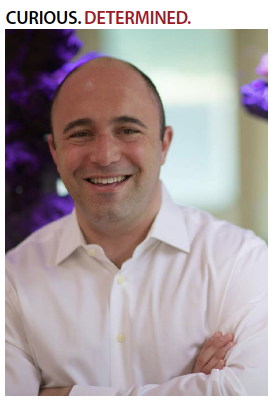 Providing a Voice for the Patient
Providing a Voice for the Patient
TITLE: CEO
COMPANY: Inspire
EDUCATION: BA, Economics, BS, Physics, George Washington University
FAMILY: Wife, two children; parents who always encouraged him to try new things and succeed
AWARDS/HONORS: PharmaVOICE 100 2014, 2016
More than 10 years ago, Brian Loew had a vision to make a difference in health outcomes by creating a large community of patients who would make clinical trial recruitment a breeze. That first goal for the community may have been a bit “audacious," he admits, but it led to the real success of Inspire, which has grown to be one of the largest patient support groups to focus on patient-to-patient interactions. With more than 1 million members, Inspire provides a place for patients to connect with each other and their advocacy organizations for everything from peer support to answering questions about their experience. Each day, about 1,000 new members join the Inspire community.
The two time PharmaVOICE 100 honoree speaks passionately about his business and what he hopes to accomplish through his innovative community platform. When first establishing the business, Mr. Loew met with a lot of skepticism regarding its value because it had never been done. Mr. Loew tackled the challenges of the task by creating partnerships with the most trusted nonprofit names in health. The first partnership was with the Children’s Inn at the National Institutes of Health (NIH), which supports children who were in clinical trials at NIH. Other groups soon followed, including the American Lung Association and the National Osteoporosis Foundation.
Today, Inspire partners with more than 100 nonprofit organizations, many of which provide subject matter experts to play a role in the communities. Mr. Loew says this adds an incredible amount of credibility to the communities and value to the members. When members join an Inspire community and see the trusted brand of one of its partners, it conveys the sense of a credible, safe but trusted space, he says.
In addition to the patient community platform, Inspire is able to share deidentified patient-level data with researchers to help understand the patient experience better and incorporate this understanding into research activities. Researchers are able to capture patient experiences that would be lost otherwise. In this way, Mr. Loew and Inspire are making sure that patient needs and experience are not only considered, but are an integral part of pharmaceutical development from the outset, no matter the disease or condition under study.
Mr. Loew is looking forward to continuing to grow Inspire, and also focus on providing more community opportunities for rare diseases. Already, Inspire has the largest population of rare disease members than any other community — nearly one-quarter of its members have a rare disease.
“Rare disease is extraordinary because it has a very long tail," he says. “About one in every 10 people has a rare condition, but they’re spread out over 7,000 different conditions."
In the Inspire community, rare disease members will write about their rare disease using words that are so specific to that rare disease that it leads to more search traffic through Google, for example. Those searches lead to more people finding and joining rare disease groups that pertain to them, so there are continually clusters of information about all these different rare diseases cropping up, whether it’s Wilson’s Disease or Von Hippel–Lindau, for example. This turns into a tremendous resource for members, Mr. Loew says.
“That’s where the Inspire tagline ‘Together We’re Better,’ comes from," he says. “It’s literally about members talking about their condition that allows other people to discover the conversations, and then the groups become stronger."
This is how a group of women in the Inspire’s Women Heart community with a rare condition called SCAD, spontaneous coronary artery dissection, discovered one another. They banned together to present themselves to the Mayo Clinic to find a researcher who would research SCAD. It was this kind of organic self-discovery that led to the largest study ever of SCAD.
Results like this, with more undoubtedly on the horizon, are what make Mr. Loew’s vision for Inspire to be a valuable partner for industry and patients alike, which will lead to better health outcomes for many people. Colleagues say Mr. Loew’s reliability, commitment, and forward-thinking have been instrumental in Inspire’s continued success.
PV: What do you see changing in the near future within the industry and at Inspire?
Loew: I see a lot of interest and potential to make really powerful advances in genetics and genomics. There are three factors at play that are all happening simultaneously.
One is the price of genetic sequencing, which has been plummeting — and is now down to $1,000 for full genome sequencing in some cases. This is a big deal.
Second, patients are increasingly informed and interested in talking about their genetic makeup. It used to be that we would only see these discussions happening in certain Inspire communities. For example, in our advanced breast cancer community we would see plenty of women talking about whether they’re HER2 positive or triple negative. These types of conversation have increased continuously. The difference now is that people with other medical conditions, even beyond oncology, are talking about their genetic profile.
Thirdly, the pace of genetic discovery has been accelerating. There are all sorts of discoveries being made by really progressive companies, such as human longevity and others in addition to the discoveries such as Myriad and other companies are making. I feel there’s enormous opportunity.
The future is going to involve patient-accelerated discoveries in genetics.
The problem remains, just as it does with clinical trials, that for many genetics studies there aren’t enough patients with a 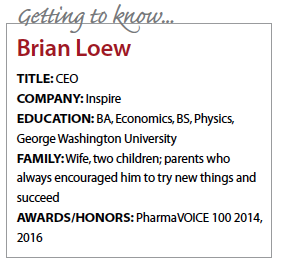 particular genetic mutation. But if we can use the power of the community to search for people who have a particular genetic profile combined with certain physical characteristics, this would be a great boon for the future. I would be absolutely thrilled if Inspire could play a meaningful role in accelerating the pace of genetic progress.
particular genetic mutation. But if we can use the power of the community to search for people who have a particular genetic profile combined with certain physical characteristics, this would be a great boon for the future. I would be absolutely thrilled if Inspire could play a meaningful role in accelerating the pace of genetic progress.
PV: Why have you chosen to apply your skills to this industry?
Loew: I wouldn’t want to spend my time doing something that I didn’t feel was making a difference. In the industry there’s a general feeling that aside from making a living, what all of us are doing is important. There is a feeling of altruism or contribution that everyone seems to feel. Also, there is an assumption that patients are cynical or critical of pharma companies, but at Inspire when patients talk about the issues we actually find that’s not the case. We often find the discontent is sensationalized by media. What we generally see is that patients want to be well. They see treatments as a way to make that happen. People want to try to optimize their situation.
PV: How do you believe your leadership style inspires others to reach their personal and professional goals?
Loew: I am not a micromanager; it’s not my style. I hire the most intelligent, capable people I can find, and then support them to achieve their best. At a company like Inspire, there is no way for a single person to be excellent at all of the skills required to run the business. And so I try to cultivate a mutual admiration society in which each person is valued for skills and achievement and collaboration. Nothing makes me happier than to see one member of the team teaching something new to another member.
PV: How do you strive to drive innovation in your company and in the industry?
Loew: When I started Inspire, I still naively assumed that everyone wants to be innovative, that improvement is a basic goal everyone seeks. I’ve since learned that this is not true: many people are content with what we have at any moment, and, further, some people reject innovation as unsettling and even dangerous. So, given this reality, I’ve learned that with some people, both at Inspire and more broadly in the industry, innovation must be encouraged and pushed. At Inspire in particular, I have added innovation as a core value against which all employees are graded during annual reviews. And I try to encourage an environment throughout the company in which innovation is encouraged and rewarded, despite the occasional, inevitable failures. And we are careful not to punish those failures, but rather to learn from them and iterate and improve.
PV: What mark would you like to leave on this industry as your legacy?
Loew: To establish once and for all that patient centricity is the best model for medicine, and to provide rich examples of why this must be true, and how it was successful. This story can only be told properly if it includes patient voices, for those are vivid, authentic, and cannot be ignored.
PV: How important is it for you to mentor and develop the next generation of leaders?
Loew: It makes me happy to help others avoid mistakes I have made, and find easier paths to success. My sense is that there is sincere camaraderie among entrepreneurs in healthcare. There are fewer sharp elbows than you might expect. All of us seem to feel that we are a part of something important; that we are doing our part to accelerate progress; but we also know that we didn’t choose the easiest industry to try to change. So there is a lot of willingness to cooperate. (PV)
Matt McNally
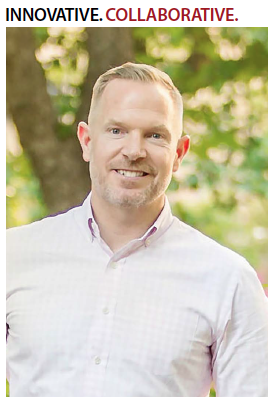 A Leader for the New Age of Marketing
A Leader for the New Age of Marketing
TITLE: President Digitas Health/Chief Media Officer Publicis Health
COMPANY: Digitas Health LifeBrands/Publicis Health
EDUCATION: BS, University of Delaware – Lerner College of Business and Economics
FAMILY: Husband, Ralph Bassett
Bucket List: Two weeks in Bora Bora; complete Kona Ironman
AWARDS/HONORS: Publicis Health Media, Advertising Age’s Best Places to Work in 2016;
ASSOCIATIONS: Philadelphia Interactive Marketing Association, founding board member; Google Health Advisory Panel; Philadelphia board of Big Brothers of America; Governing Board of Directors of Big Brothers Big Sisters Independence Region
Social media:
Tweet: @MattMcNally4
As Publicis Health’s newly named chief media officer and president of Digitas Health, Matt McNally assumes a double role as the heart, soul, and brain of the company’s global health media operations, and as leader of its largest business unit in North America, Digitas Health. More than 800 employees fall under his leadership and according to colleagues, not a one doesn’t absolutely love working for Mr. McNally.
A three-time PharmaVOICE 100 honoree, Mr. McNally exudes charisma and a natural ability to inspire that makes him respected by both clients and colleagues. The one thing that makes his leadership unique is how deeply — almost fanatically — those who work for him love him, especially the next generation of rising stars. People view Mr. McNally as a leader who they can believe in and emulate — a true role model.
Mr. McNally knows how to push innovative boundaries as well as nurture traditional infrastructure to drive true client success. Clients say he and the agency are always willing partners on new and innovative digital marketing programs, from unique original content to programmatic audience targeting, and they are staunch advocates for the value of foundational content-based marketing programs.
Mr. McNally believes collaboration and partnerships are the way forward for bringing what clients. Today, those connections are going beyond the usual, to include many partnerships with organizations outside the industry.
“The trend is going to be partnerships with unusual bedfellows," he says. “We’re connecting clients with companies such as Under Armour and Dreamit and the NYC Media Lab. We connect our clients to interesting partners that they would not have expected and you can just watch the benefits double and triple. We’re going to see more partnerships like that these, partnerships that we wouldn’t have even thought about 12 to 24 months ago. I love this type of connectivity."
Mr. McNally’s vision and leadership on a particular project for a top pharma client produced an $18 million savings for the client and a new procedure for working across the agency. The path to success on this project was a bumpy one, but he had the right people on the team, and when he didn’t, he coached and mentored or found the person who would be a “right fit" for the client, and secured talent that would work best on this important project.
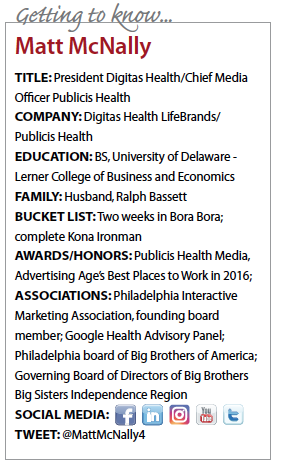 Colleagues say Mr. McNally continues to raise the bar on behalf of clients to ensure they achieve the goal of reaching more of the appropriate patients for a therapy. He is patient-centered and takes his vast knowledge in media strategy to partner with clients to get great outcomes for patients.
Colleagues say Mr. McNally continues to raise the bar on behalf of clients to ensure they achieve the goal of reaching more of the appropriate patients for a therapy. He is patient-centered and takes his vast knowledge in media strategy to partner with clients to get great outcomes for patients.
PV: How is collaboration driving a new transformation in the industry?
McNally: We need to look beyond our four walls to drive innovation and change. To create transformation, we need to look for ideas from outside our industry. For far too long we have had this idea of who we wanted to hire: they need pharmaceutical experience, healthcare experience, media experience. But when we started to look to hire outside of our industry we were getting really unique ideas. It’s not about what our competition is doing in the oncology marketplace. We need to look at what companies such as Amazon, Uber, Lyft, and P&G are doing to innovate in marketing. We have ex-bartenders who have a passion for healthcare because their mother had breast cancer and they had really smart ideas for app development. We have young people who are all tech savvy and have a unique connection to new technology. This is something that I think needs to happen more in our industry. I think partner-ability and a one-plus-one-equals-three way of thinking is what will transform the industry.
PV: How do you drive innovative thinking at your agency?
McNally: We like to constantly reinvent and rethink and not use the idea of: “Well, we’ve always done it this way." This is my least favorite phrase. Instead, we give people permission to bring in new thinking and we like to use the vernacular “how about," or “what if" versus “last year, we had this mix, or we launched the product this way or this was the brief."
Because of the pace of change in marketing, driven through digital data and technology, what we did last year is not relevant today. There are new outlets. There are new data sets. There are new media channels. There are new ways to gather insights and we can’t rely on the same old playbook and the same way of working. We like to reward projects that may not even get sold through; we like the big ideas even if they never get executed because someone had the courage to bring them forward. The idea may have been really smart but for whatever reason it may not have gotten the funding. We like to celebrate that thinking, because that fuels more thinking and gives people the courage to take some risks.
PV: What do you think the life-sciences industry is going to look like in the next five or 10 years?
McNally: We’re going to see more mergers and more consolidation. We’re seeing pipelines change and evolve, and I think the definition of life sciences is going to change. I think we’re going to see more health technology companies and EMR-based companies and new advances in diagnostics. I think we are going to see drug manufacturers taking on a different makeup of what they look like. We’re trying to prepare for and create capabilities for and hire the talent as we need as we look to a new type of constellation of companies.
PV: What would you like your legacy to be?
McNally: When people mention my name or think about working with me, I would like to be someone who brought a smile to their face and hopefully recall the positive impact that I’ve had on them. Over my 20-plus year career, I’ve gone to the weddings of my colleagues and now their kids are going to college and we’re still connected. I would like to be remembered by the relationships, the trust, the inspiration that I hopefully instilled in people and the confidence that I gave them.
People throughout the Publicis Groupe remark about the people factor that we in the healthcare division bring to the work and to relationships. We want to be good people to work with and Nick Colucci has instilled that in us. Be good to one another, be good to our clients. We’re all in this together.
You asked a little bit about leadership and I think a lot of times being a good leader is knowing when to be a good follower. Knowing when I need to take a step back and let the team lead me, let the team make a decision, let them know that I “work for them" is important. I think this generates respect and helps build relationships.
PV: What advice would you provide to future leaders?
McNally: Three things are very critical in life. First, make sure you have really solid relationships because the relationship is what it’s all about. Second, have good ideas. And then the third thing is get somebody to part with the money. The relationships are the toughest part. But they’re the critical part that allows you to keep your feet on the ground and your head in the clouds for ideation. Then you get someone to pay for your ideas. If you can do those three things, I think you’ll be very successful. (PV)
Dr. Jules Mitchel
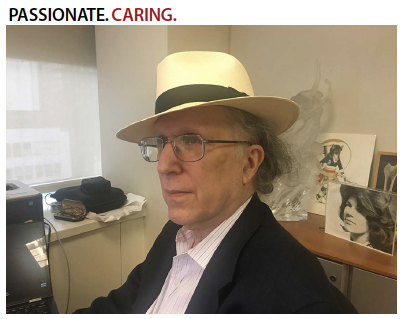 Leading the Paperless Charge in Clinical Trials
Leading the Paperless Charge in Clinical Trials
TITLE: President
COMPANY: Target Health
EDUCATION: BS, Biology, Queens College; MS, Biology, University of Oregon; MBA, Pace University; PhD, Biology, New York University
FAMILY: Wife and life partner, Joyce
AWARDS/HONORS: Small Business Global Trade Award from World Trade Week NYC 2016; Certificate of Appreciation in Recognition of Outstanding Service and Contributions on Behalf of CTTI (Clinical Trials Transformation Initiative); Sponsor of the Year (Center for Dermal Research; Leaders Society (Dermatology Foundation)
Associations: CTTI, ASCO, AAD, AUA, ACRP, DIA, eClinical Forum
Social Media:
Tweet: @JulesMitchel
Under Jules Mitchel, Ph.D.’s innovative leadership, Target Health continues to move the needle on paperless data collection and management for clinical trials. The company’s patented eSource solution was key in the first FDA approval of a product where direct data entry was used at the time of the study visit. And a publication of the results of that study appeared in JAMA this past February. The company also launched Target e*ICF for electronic informed consent and submitted an NDA with seven studies all with direct data entry.
The study published in JAMA related to evaluating whether use of a scalp cooling system is associated with a lower amount of hair loss among women receiving specific chemotherapy regimens for early-stage breast cancer and to assess related changes in quality of life. Among women undergoing non-anthracycline-based adjuvant chemotherapy for early-stage breast cancer, the use of scalp cooling vs. no scalp cooling was associated with less hair loss at four weeks after the last dose of chemotherapy.
Target Health’s innovations have all impacted the development of the direct data entry and risk-based monitoring guidance, e-informed consent implementations, and the Clinical Trials Transformation Initiative to name a few.
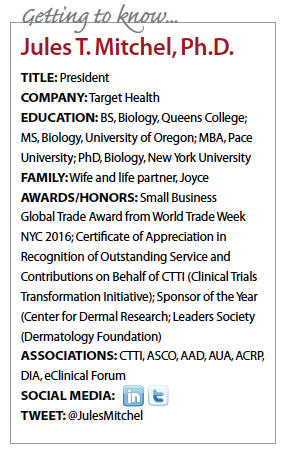 Dr. Mitchel established his full-service CRO in 1993 with a vision to combine his entrepreneurial spirit, experience, and insightful knowledge of the pharmaceutical industry with the industry’s underserved needs. Dr. Mitchel, and his wife and Target Health CEO Joyce Hays, have built and continue to grow the company as an internationally recognized full-service CRO with expertise in clinical research, regulatory affairs, biostatistics, data management, Internet-based clinical trial electronic data-capture, software development, and drug and device development.
Dr. Mitchel established his full-service CRO in 1993 with a vision to combine his entrepreneurial spirit, experience, and insightful knowledge of the pharmaceutical industry with the industry’s underserved needs. Dr. Mitchel, and his wife and Target Health CEO Joyce Hays, have built and continue to grow the company as an internationally recognized full-service CRO with expertise in clinical research, regulatory affairs, biostatistics, data management, Internet-based clinical trial electronic data-capture, software development, and drug and device development.
Dr. Mitchel had the innovative vision from very early on that the Internet could be used to save time and money in clinical trials as well as to increase efficiencies and have validation software that far exceeds the accuracy of human review. Over the decades, Dr. Mitchel has made more than 60 IND submissions and 12 NDA submissions, numerous premarket approval applications, biologics license applications, and generated several dozen position papers on developing products. He has an impressive client list where he currently represents more than 55 companies at FDA and more than 150 companies since Target Health was founded.
A CEO of several pharma/medical device companies commended Dr. Jules for his ability to provide invaluable assistance and guidance in navigating the regulatory minefields and securing IND meetings, as a well as 510(K) clearances for substantial claims.
Internally, Dr. Mitchel elevates talent development to a new level with his 70-plus employees by having regularly scheduled company gatherings that acknowledge individual achievement, attainment of group goals, excellence in recruitment and retention. He even has his opera-singing and concert pianist employees to share their talents with the entire Target Health team.
This three-time PharmaVOICE 100 honoree is an extraordinary leader with a firm conscientiousness in purpose, innovation, and achievement with integrity, entrepreneurial spirit, and an unwavering commitment to talent-development, all exhibited through out the growing of a financially solid business enterprise.
PV: How do you mentor both internally and outside of the company?
Mitchel: In terms of leadership, we encourage people to be leaders. The whole idea is to give people ownership in what they do and to support them even when there’s a problem. The other thing is that we are candid. I share a lot of my experiences and struggles so that people don’t feel isolated when a project goes differently from planned. I encourage our folks to grow. We have had employees here for 15, 16, 17, 18 years.
PV: What are some of the things that you’ve done to transform the industry?
Mitchel: Our biggest contribution to the industry is the paperless clinical trial. What we mean by the paperless clinical trial is to fundamentally eliminate paper as any type of source record. Hopefully over the next year or two it’ll be accepted as a way of doing business.
The whole idea of the paperless clinical trial is not just about mobile devices or integration with electronic health records, but how to get the data in real time, whether it’s direct data entry at the time of the office visit via a Web-based system or through a patient’s own device. There’s a tendency to think about using a mobile device to measure how people are walking with Parkinson’s disease, for example, which is incredibly valuable. But it’s not just that. We have to separate the toys from the tools. For example, with our software, 98% of the entire trial, once it’s up and running, is on one website. People don’t have to go to different places to get different information. It’s all at one place. We hope that whole concept — not just one part of it — of the paperless clinical trial will be adapted.
PV: What do you believe will be some of the drivers toward a paperless environment?
Mitchel: I think the biggest drivers are time and money. With a paperless clinical trial, we may have to send a monitor to the investigator site twice a year instead of six or seven times a year. Just the cost savings of four or five monitoring visits per sites is enormous. We estimate somewhere between $15,000 and $20,000 a year of savings per clinical research site. In addition to just the cost savings, is the ability to respond in real time to events.
For example, we don’t have to wait two weeks until a site enters data to find out that something is going on. So, first we can minimize protocol violations and fix issues even within the software itself or the application.
Also, because we monitor in real time, we can reduce the number of queries. For a big study we just did with a 900 patients and 40 centers, only 2% of forms were queried. Of those, half were database changes. We can quickly identify if there is a problem with site No. 1, site No. 2, or site No. 3, then quickly fix the problem so we don’t see the same problem a hundred times. This is the main advantage of seeing data in real time. If we run studies efficiently, it will not cost a billion dollars to develop a drug.
One of the problems is that drug failures are not stopped early enough and part of the reason is because of a lack of data. A program might run for six months before it’s discovered that it should be stopped.
Let’s hypothesize that a big pharma company is running 10 programs that need to be stopped, that’s six months times 10. That’s 60 months of money being spent for nothing, which is enormous. Data in real time is invaluable.
PV: What mark would you like to leave on the industry as your legacy?
Mitchel: Before I hang up my sneakers or even after I hang up my sneakers, I would like to be known as someone who pushed the industry to accept the whole concept of the paperless clinical trial. And that even though there will be other people pushing in this direction, and even maybe doing even more exciting things than we have done, I would like Target Health to be known as the company that created the gateway into this process.
When I first joined the industry many years ago, I said to the head of statistics at one company: “Why do we have all of these papers? After all we have computers. “ There were adverse event forms in triplicate at every single visit. There were medication forms at every single visit.
I asked the same person: “Why don’t we just put the sheets in the back of the book?"
He yelled back at me: “Jules, you’re screwing up all of the programs." I said, “But I’m gonna save you 2,000,000 sheets of paper." He said: “Shut up."
So, we saw the entire picture, not one aspect of a picture, but all of it and have been an innovator in the area of the paperless trial. This is what makes us unique. (PV)
Wendy White
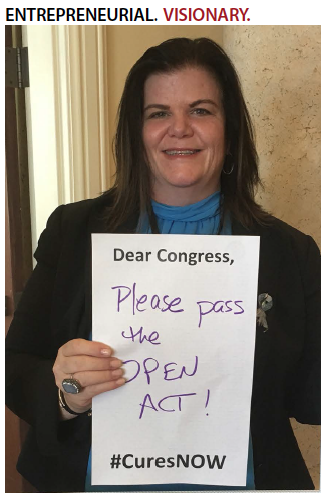 One Woman Warrior Against Rare Disease
One Woman Warrior Against Rare Disease
TITLE: Principal Consultant
COMPANY: Wendy White Consulting
EDUCATION: BS, Quantitative Business Analysis, Indiana University, Kelly School of Business
FAMILY: Husband, Paul; children, Nate, Colin, Casey; and dog Lakota
AWARDS/HONORS: PharmaVOICE 100 2015, 2012; Top 50 Social Media Influences in the Rare Disease Space, World Orphan Drug Congress, 2012; 5000 Fastest Growing Companies, Inc. Magazine, 2012; Inc. 5,000 companies list, 2013, 2012, 2011, 2010; Manny Heart Award, Med Ad News, 2011; President’s Award, Healthcare Businesswomen’s Association, 2008
ASSOCIATIONS: Global Genes – Allies in Rare Disease, Healthcare Businesswomen’s Association, NORD
Wendy White has been on an impactful journey for more than 20 years, filling roles as patient advocate, consultant, strategist, activist, author, entrepreneur, industry leader, and mother. In 1998, she founded Siren Interactive, the only marketing agency to focus exclusively on rare diseases. Most recently she served as senior VP of Dohmen Life Sciences’ rare disease unit. She has held leadership positions with the National Organization of Rare Disorders (NORD), the Healthcare Businesswomen’s Association (HBA), and is now chair of Global Genes. Today, as she launches her new firm, Wendy White Consulting, her name has become synonymous with innovation in rare disease.
Ms. White’s journey began when her young daughter was diagnosed with a rare condition. The impact of this news, and the experience it led to, helped shape Siren’s vision and direction. In the process of her work, she became a tremendous partner to biotechnology and pharmaceutical companies working in rare disease. By using new ways to communicate and engage with patients, she helped to bring more treatments to more rare disease patients more rapidly.
She soon became a pioneer in recognizing the power of patients and caregivers in influencing health outcomes, and formulating innovative strategies for all stakeholders to work together for a common cause. Her long-term vision has always been to integrate patient-level insights into the drug-delivery continuum. She knew this would take specific and extensive credentialing — she has experience in more than 36 rare disease communities — as well as a role in industry thought leadership. In 2009, she co-authored and published “Uncommon Challenges; Shared Journeys—Stories of Love, Hope, and Community by Rare Disease Caregivers."
She also spent five years on the board of the NORD, and is chair emeritus for the HBA, where she has worked for gender parity in the industry, playing a significant part in forwarding their inclusive mission to transform the future of healthcare.
“We have a large group of people who are focused on bold thinking around aligning change with reality," she says. “We know that 95% of healthcare decisions are made by women across the world, and yet we don’t have a significant representation of women at the highest corporate levels in the industry. It just doesn’t make any sense. The more we can work together through the HBA and other organizations to show the positive business impact of diversity at every level, the more opportunities for everyone."
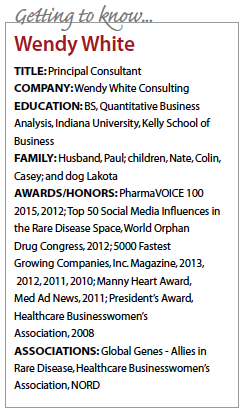 Ms. White is particularly excited about her role at Global Genes where, after two years of service on the board, she has taken on the position as chair, looking to develop a model for the industry that will facilitate systemic change. She is working with other industry innovators on a unique partnering event at Global Genes to facilitate new possibilities. Focused solely on rare disease, this event seeks to introduce investors to a broader range of partners, expanding beyond biotech and healthtech companies to also include patient entrepreneurs and patient groups.
Ms. White is particularly excited about her role at Global Genes where, after two years of service on the board, she has taken on the position as chair, looking to develop a model for the industry that will facilitate systemic change. She is working with other industry innovators on a unique partnering event at Global Genes to facilitate new possibilities. Focused solely on rare disease, this event seeks to introduce investors to a broader range of partners, expanding beyond biotech and healthtech companies to also include patient entrepreneurs and patient groups.
“It is no longer about companies simply listening to patients or mapping the patient journey; it’s about actually partnering with them, arm in arm, to understand they are people first, then patients, then powerful activists for progress," she says.
After 15 years running Siren, Ms. White sold the agency to Dohmen Life Sciences in 2015. She has now established Wendy White Consulting to partner with organizations operating across the spectrum in genetic rare diseases. She is particularly driven to help these organizations understand and develop the foundational structure that is critical for success — a patient-centered viewpoint and a transformational culture.
PV: Do you see a difference between the term disruption and the term transformation in the industry?
White: I do, as has been explored in several recent articles, Disruption is outside in. Market forces generally move at a faster rate than the internal transformation required to accommodate them. Nokia is a prime example. That company had 80% of the global mobile phone market when the iPhone was introduced. A year later, it had less than 10%. Why? Because they weren’t paying attention. They were complacent, and did not tap into diverse points of view that could have signaled the significance of the iphone disruption. Transformation, on the other hand, is change from the inside out — organizational change that encourages and allows new ways of thinking to emerge. Amazon is an excellent example of a transformationally driven company. Initially, they made their money selling print books, but with a keen eye on the potential changes of the future. Soon, they owned the market for digital books, and are still moving, applying their distribution expertise into areas as diverse as food, as evidenced by their recent acquisition of Whole Foods.
If we apply that same forwarding thinking model to the rare disease industry, it’s clearly the empowered patients who are the potential disruptors, the ones who led the entire healthcare industry into social media, for example. At the same time, many of our organizations, particularly in the biotech space, are putting transformational inside-out thinking to work by listening to all constituencies and creating a culture of continual change to stay ahead of disruptive market forces.
PV: How do you believe your leadership style inspires others?
White: I would describe my style as entrepreneurial, with a purpose-driven model. I start with a clear vision and overall direction, then carefully assemble the best and most integrated team to create and implement the plan to fully realize that vision. I believe people are looking for purpose. Given that, if you focus not on the day-to-day work, but the overall impact your team can make, people step up professionally and personally — often more than they ever imagined for themselves.
PV: How are you driving innovation in the industry?
White: We are the middle of a huge wave of change — both inside and outside — and we need fully empowered entrepreneurial thinking at every level. Our focus absolutely needs to be customer-centric, and within that we need to challenge ourselves to continually be open to new ideas to anticipate what our patients will need — today, tomorrow, and into the future. This the reason I took on the chair roles at the HBA and now at Global Genes. My hope is to get people who represent diverse elements in the industry to work together at all levels and to think about how we can collectively make a huge impact in our industry. We need to think about the changes we want to see happen, and about how to get a seat at the table to ensure we have the clout that will make the difference required for genuine results.
I launched my new firm, Wendy White Consulting, to do just that — to help the full range of entities in the industry, from patients to big pharma — to think about what’s required to get and stay ahead of the curve, to be driving rather than responding, and absolutely ensuring they aren’t overtaken by forces moving faster than they can keep up with. I’m confident, that by bringing an entrepreneurial mindset to the industry, and ensuring companies think about diversity, they will successfully bring innovation into their planning and their culture to lead change.
PV: What type of impact did you want to make on the world of healthcare?
White: One of my core beliefs is that innovation happens at the margins. If you look at any type of change curve, and understand the people who are or will be most affected by it, you will be able to clearly see what’s going to drive that innovation — the people under the ends of the bell curve. For example, when I look at genetic rare diseases, where I spend a lot of my time and effort, I can see where parents are pushed to their limit trying to save their children’s lives. I am devoted to supporting innovation here and to ensure positive changes empower patients, improve pricing, and that we deal with the ethics surrounding genetic science.
At Global Genes, I have the incredible opportunity to think about how we can model working together collaboratively across sectors to show how to drive change, which will then help the rest of the industry. As has happened so many times, once companies start to see change happening in the rare disease end of the industry, they use it as a model moving forward. It’s when the margin becomes mainstream that innovation is baked into the culture and practice of healthcare. It’s exciting.
Right now, 95% of those living with rare disease, mostly children who are born with a genetic condition, don’t have access to any therapy. We know that no single organization or stakeholder is going to be able to do at all to solve this problem. We need to collaborate to increase the velocity of innovation to make the biggest difference. (PV)

















